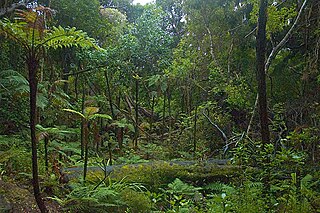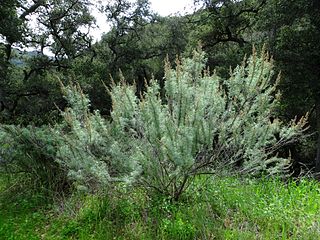
Eschscholzia californica, the California poppy, golden poppy, California sunlight or cup of gold, is a species of flowering plant in the family Papaveraceae, native to the United States and Mexico. It is cultivated as an ornamental plant flowering in summer, with showy cup-shaped flowers in brilliant shades of red, orange and yellow. It is also used as food or a garnish. It became the official state flower of California in 1903.

Umbellularia californica is a large hardwood tree native to coastal forests and the Sierra foothills of California, and to coastal forests extending into Oregon. It is endemic to the California Floristic Province. It is the sole species in the genus Umbellularia.

Ulva is a small island in the Inner Hebrides of Scotland, off the west coast of Mull. It is separated from Mull by a narrow strait, and connected to the neighbouring island of Gometra by a bridge. Much of the island is formed from Cenozoic basalt rocks, which are formed into columns in places.

Ulva Island is a small island about 3.5 km (2.17 mi) long lying within Paterson Inlet, which is part of Stewart Island/Rakiura in New Zealand. It has an area of 267 hectares, of which almost all (261 ha) is part of Rakiura National Park. It was named after the island of Ulva in the Inner Hebrides of Scotland and was formerly called Coopers Island.

Darlingtonia californica, also called the California pitcher plant, cobra lily, or cobra plant, is a species of carnivorous plant. It is the sole member of the genus Darlingtonia in the family Sarraceniaceae. This pitcher plant is native to Northern California and Oregon, US, growing in bogs and seeps with cold running water usually on serpentine soils. This plant is designated as uncommon due to its rarity in the field.

The sea lettuces comprise the genus Ulva, a group of edible green algae that is widely distributed along the coasts of the world's oceans. The type species within the genus Ulva is Ulva lactuca, lactuca being Latin for "lettuce". The genus also includes the species previously classified under the genus Enteromorpha, the former members of which are known under the common name green nori.

The California scrub jay is a species of scrub jay native to western North America. It ranges from southern British Columbia throughout California and western Nevada near Reno to west of the Sierra Nevada. The California scrub jay was once lumped with Woodhouse's scrub jay and collectively called the western scrub jay. The group was also lumped with the island scrub jay and the Florida scrub jay; the taxon was then called simply scrub jay. The California scrub jay is nonmigratory and can be found in urban areas, where it can become tame and will come to bird feeders. While many refer to scrub jays as "blue jays", the blue jay is a different species of bird entirely.

Green laver, known as aonori in Japan, sea cabbage (海白菜) or hutai (滸苔) in China, and parae (파래) in Korean, is a type of edible green seaweed, including species from the genera Monostroma and Ulva. It is commercially cultivated in some bay areas in Japan, Korea, and Taiwan, such as Ise Bay. It is rich in minerals such as calcium, magnesium, lithium, vitamins, and amino acids such as methionine. It is also called aosa in some places in Japan.

Ulva lactuca, also known by the common name sea lettuce, is an edible green alga in the family Ulvaceae. It is the type species of the genus Ulva. A synonym is U. fenestrata, referring to its "windowed" or "holed" appearance, Despite the name, it is not a lettuce

Juniperus californica, the California juniper, is a species of juniper native to southwestern North America.

The California gnatcatcher is a small 10.8 cm (4.3 in) long insectivorous bird which frequents dense coastal sage scrub growth. This species was recently split from the similar black-tailed gnatcatcher of the Sonoran and Chihuahuan deserts. This bird is often solitary, but joins with other birds in winter flocks.

Vitis californica, with common names California wild grape, Northern California grape, and Pacific grape, is a wild grape species widespread across much of California as well as southwestern Oregon.

Coastal sage scrub, also known as coastal scrub, CSS, or soft chaparral, is a low scrubland plant community of the California coastal sage and chaparral subecoregion, found in coastal California and northwestern coastal Baja California. It is within the California chaparral and woodlands ecoregion, of the Mediterranean forests, woodlands, and scrub biome.

Artemisia californica, also known as California sagebrush, is a species of western North American shrub in the sunflower family.

Ulva intestinalis is a green alga in the family Ulvaceae, known by the common names sea lettuce, green bait weed, gutweed, and grass kelp. Until they were reclassified by genetic work completed in the early 2000s, the tubular members of the sea lettuce genus Ulva were placed in the genus Enteromorpha.

Ulva linza is a green alga in the family Ulvaceae that can be found in British Isles.

Sea hares are gastropods without hard shells, using their specialized ink as their main defensive mechanism instead. Their ink has several purposes, most of which have a chemical basis. For one, the ink serves to cloud the predator's vision as well as halt their senses temporarily. In addition, the chemicals in the ink mimic food. Their skin and digestive tract are toxic to predators as well. They are also seen to change their feeding behaviours in response to averse stimuli.

Ulva australis, the southern sea lettuce, is a species of bright green coloured seaweed in the family Ulvaceae that can be found in waters around Australia and was first described by Swedish botanist Johan Erhard Areschoug. It is an edible green algae, although sometimes designated as a seaweed. General characteristics of Ulva australis include a smooth surface, distromatic blades, lobed fronds, and thallus color from dark green to light grass green. It can be either free floating or attached by a single holdfast. Its cells appear to be irregularly arranged, have rounded edges, and have shapes such as rectilinear, square, and pentagonal.

Ulva Island-Te Wharawhara Marine Reserve is a marine reserve covering an area of 1,075 hectares south-west and north-east of Ulva Island, in the Paterson Inlet of New Zealand's Stewart Island. It was established in 2004 and is administered by the Department of Conservation.



















